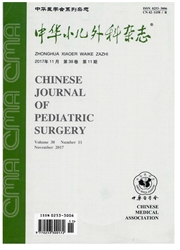

 中文摘要:
中文摘要:
目的采用2-D/质谱电泳方法,比较孕17d正常组胎鼠和全反式维甲酸诱导的显性脊柱裂胎鼠羊水蛋白表达谱的变化,筛查先天性显性脊柱裂相关羊水标记物。方法孕10d大鼠,采用全反式维甲酸胃管灌饲的方法建立先天显性脊柱裂动物模型24只(脊柱裂组),正常对照组9只(正常组)。孕17d晨,麻醉孕鼠,显微镜下获取每个胎囊的羊水及胎鼠,并检查胎鼠畸形情况。提取羊水蛋白质,merck试剂盒去除高丰度白蛋白和IgG,行2-D、胶体染色、图像扫描分析及质谱检测,Western—blot进一步验证2-D结果。结果鉴定出6种蛋白质(其中1种蛋白质可能对应多个蛋白点):甲胎蛋白(AFP)、转铁蛋白(transferrin,TF)、信号识别颗粒受体B亚基(srprb)55kDa、srprb 77kD、α-1抗蛋白酶及载脂蛋白A4(Apo A4)。其中,Apo A4和Srprb 77kDa在脊柱裂组表达下调,而TF、Srprb 55kDa和α-1抗蛋白酶在脊柱裂组表达上调。46个蛋白质点被鉴定为AFP及其片段,11个AFP蛋白点在脊柱裂组表达降低,35个蛋白点在脊柱裂组表达升高。通过Western-blot共发现69kDa、52kDa、36kDa、24kDa和14kDa5种分子量的AFP片段,其中69kDa的AFP在脊柱裂组和正常组含量均为最高。脊柱裂组与正常组比较,AFP上调42%,而Apo A4下调44%,组间差异有统计学意义(P〈0.05)。结论本研究发现羊水中6种蛋白质与显性脊柱裂畸形发生有关,进一步研究这些差异表达蛋白,可以为了解脊柱裂的发病机制和产前诊断提供实验依据。
 英文摘要:
英文摘要:
Objective To explore the potential biomarker for early diagnosis of spina bifida aperta by analyzing of proteomic profile of anmiotic fluid in rats with spina bifida aperta (SBA) induced by all-trans retinoic acid (ATRA). Methods The pregnant rats were randomly divided into 2 groups: SBA group (24 rats) and normal group (9 rats). SBA was induced by a single intragastric administration of ATRA to the pregnant rats on gestational day 10 (E10). All pregnant rats were sacrificed by an overdose chloral hydrate on E17 day, and fetuses and amniotic fluid were collected. Albumin and IgG were removed using Protein A/G kit to increase the concentration of target proteins. The proteomie profiles of amniotie fluid were analyzed by two-dimensional gel eleetrophoresis (2-DE)/mass spectrometry (MS). Results Six proteins were found to be differentially expressed in the amniotic fluid of SBA rats. Of the 6 proteins, transferrin, alpha-1 antiproteinase and signal recognition particle receptor were unregulated, and apolipoprotein A IV and Srprb 77 kDa were down-regulated. Additionally, 46 protein fragments in SBA amniotie fluid were [ound, including 11 were upregulated and 35 were downregulated. A Western blot analysis confirmed the 2-DE/MS data, indicating the 6 isoforms of AFP (69-, 52-, 36-, 24- and 14-kDa) were associated with SBA. Moreover, the 69-kDa AFP was the most abundant protein in the amniotic fluid of SBA, which was increased by 1.42-fold (P〈0. 05). Conclusions Six proteins in amniotic fluid are correlated with spinal bifida aperta, and may be used as biornarkers for early diagnosis of spina bifida aperta.
 同期刊论文项目
同期刊论文项目
 同项目期刊论文
同项目期刊论文
 Therapeutic potential of in utero mesenchymal stem cell (MSCs) transplantation in rat fetuses with s
Therapeutic potential of in utero mesenchymal stem cell (MSCs) transplantation in rat fetuses with s Quantitative analysis of motor neurons of the levator ani muscle in fetal rats with spina bifida occ
Quantitative analysis of motor neurons of the levator ani muscle in fetal rats with spina bifida occ 期刊信息
期刊信息
